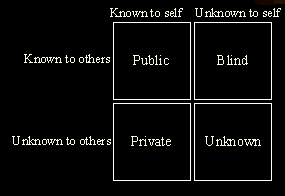JOHARI
WINDOW
The Johari Window, named after its creators
Joseph Luft and Harry Ingham, depicts aspects of
interpersonal interaction in an easy to understand
graphic way. |
.
For many of us, ever since we were little
children, we have been conditioned by our parents,
teachers and 'society' to keep our feelings very private,
hidden from the view of others. Some of us learned these
lessons so well that we frequently are able to keep many
of our feelings from ourselves. JOHARI WINDOW is a structure that deals with
self-inquiry, self-awareness, and the extent to which
that information is shared between people.
1. Public Self
The PUBLIC pane of the window contains
those things in my life that I know about myself and that
you also know about me. Things like my gender,
height and approximate weight, or other messages that I
intentionally convey to other people like you.
|
 |
.
This is my basic public personality. A very
private person such as a hermit might always maintain a
narrow PUBLIC pane, and conversely a strong extrovert
might quickly share lots and lots with others quickly.2. Private Self
The PRIVATE pane of the window is my
collection of things that I keep to myself. These might
include my favorite brand of chocolate or my erotic
preferences.
|
 |
I can choose not to share these parts of
myself with others because I may consider these private.
. . or I might consider these parts to be secrete because
I fear sharing them with another. As I begin to trust, I
am no longer afraid, and so may choose to make my
feelings more visible to others.
.
3. The
Blind Self
The BLIND pane of the window is
occasionally called the 'bad breath' quadrant. You know
this about me, but I don't know it about myself. In the
course of our interactions you might choose to tell me
things in this quadrant. The advantage of having friends
is that my BLIND quadrant shrinks by others telling me
about myself.4.
Undiscovered or Unknown Self
The UNKNOWN pane of the window is that
which is hidden from me and from you, even though it may
affect our relationship. It's potentially the most explosive
quadrant when someone doesn't know exactly who they are.
and so . . .
- the way to
decrease "hidden self" and increase
"open self" is through
the process of self disclosure, self revelation
or testimonial.
.
- by becoming more
trustful and disclosing information about
ourselves
(truthful) we reduce potential conflict and
theoretically acquire more peace.
.
- On the other hand,
self-disclosure is at risk for the individual and
the
outcome, must therefore, be worth the cost.
.
- the other person
in the equation, must give feedback and that
person must
also use it, for the process to work. Feedback is
most effective when it's:
- Solicited
rather than Imposed
- Observational - not Judgemental
- Timely & Immediate
- Specific rather than
General
|
|